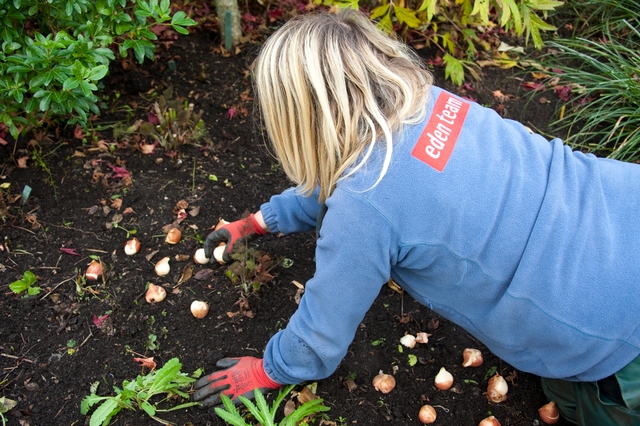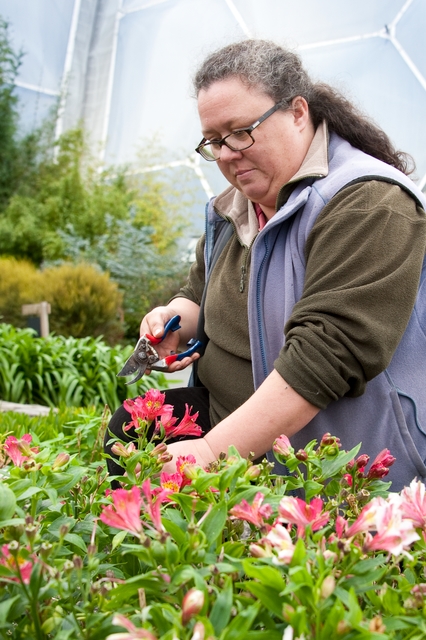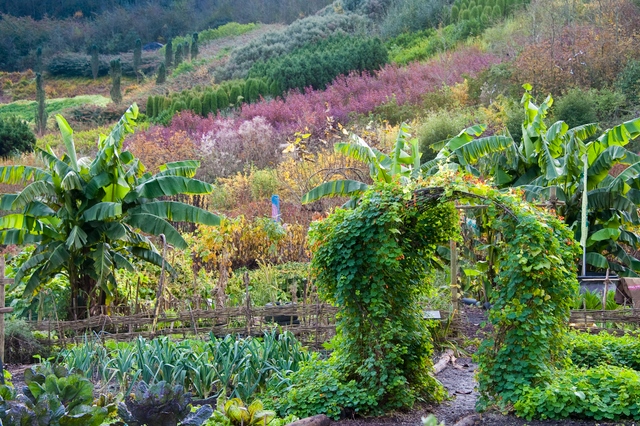
Kath planting tulip bulbs. Photographs: Charles Francis
October 2008: When the Eden Project first began to take shape in a disused china claypit, the attention of the waiting world naturally focused on the fantastic, futuristic structures of the giant greenhouses destined to become home to thousands of plants from all over the planet. But the Eden team also faced another challenge: to create a landscape which would not only provide a backdrop for the biomes, but also be the first major new Cornish garden of the 21st century.
It was the zigzag tracks carved by trucks transporting soil to the site which became the initial inspiration for the design of the garden. Twists, turns and tall trees lead visitors through the steeply-sloping site in stages, nurturing anticipation for the treats ahead: the biomes are alternately hidden and revealed at each bend in the path. Now, however, as Eden approaches its 10th birthday, the aim is to show that the journey to the biomes can be just as fascinating and enjoyable as the destination.
“The garden was designed on a large scale, but we’ve found that people are also interested in the small scale, and seeing something they can relate in within this vast landscape,” says Catherine Cutler, a member of Eden‘s green team. “So we’re trying to create some intimate spaces.”
One of these, in a sunny spot close to the valley floor, is simply called the Garden, and is designed to be “playful and restful, entertaining and contemplative, stimulating and calming, social and secluded”. Behind a hornbeam hedge is a network of curved paths with hidden seating areas; a profusion of clematis and scented climbing roses; a children’s play area with a sandpit and a willow tunnel.
Developed in partnership with Australian wine company Banrock Station, which supports environmental projects all over the world, the space demonstrates simple methods of creating an environmentally-friendly garden. The plants have been selected for their ability to attract wildlife, or tolerate drought, wind or heavy rain. Recycled timber was used for the decking and walls, and there is a shelter made from green oak.
Next door to the Garden is a living museum which explores the ancestry of some much-loved plants, through displays featuring both naturally occurring varieties and cultivated hybrids. Rows of sweet peas, in mouthwatering, ice cream colours, are perhaps the stars of the Making of Garden Flowers show, but other attractions include purple and cerise lilies in containers, surrounded by massed hardy geraniums; and a vibrant, multi-coloured dahlia display, which will have a final flourish in November, when the giant Dahlia imperialis bush produces masses of orange-centred pink flowers just as its smaller neighbours are finally fading.
Another new display highlights the many qualities of lavender. Different varieties of the herb are interspersed with pots of Impatiens ‘Ray of Hope’, which was bred at Eden from Impatiens gordonii — a busy lizzie from the Seychelles which was threatened with extinction — and the pure white Impatiens wallachiana, to produce a pale pink flower. Money raised from sales of ‘Ray of Hope’ goes to help protect other endangered species in the Seychelles.
The outdoor biome covers 13 hectares — more than 30 football pitches — and contains almost 2,000 different species and cultivars from across the world, selected for their ability to thrive in temperatures somewhere between Mediterranean heat and Arctic and Antarctic cold, such as the Indian foothills and much of the United States, as well as Cornwall and the rest of Britain.
Surrounding the Core — the innovative sunflower-shaped education building opened three years ago — are several interesting gardens, including Crops for Health, a patchwork quilt featuring arnica and echinacea, gingko biloba and opium poppy. A fine collection of miscanthus, phormium and other tall grasses provides a peaceful place to take a stroll away from the crowds.
The Spiral garden, the Core’s outdoor classroom, makes imaginative use of a small, north-facing space, and the aim is to inspire visitors to see the potential of similar sites for use as school and community gardens. There are flowers to be sniffed; leaves and grasses to be touched; rowan and hawthorn trees to sit beneath for story-telling sessions; stepping stones and hiding places; and paving slabs colour-coded to match flowers represent the seven shades of a rainbow. The enchanting hardy geranium ‘Roxanne’ clambers over the walls and produces violet-blue flowers all summer long.
Cornish children visiting the Core are also given an insight into lives of their counterparts in other parts of the world, through displays of crops such as rice and sweet potatoes which are being grown as part of Eden‘s Gardens for Life project by schools in India and Kenya.
Some of these crops can also be seen in the Global garden, on the west side of the Eden side, which shows how immigrants from all over the world are adapting the traditional British allotment by planting exotic vegetables from their own culinary cultures. Pak choi, mooli and ginger grow in the Chinese allotment; and okra and turmeric in the Indian one. An African three-way cropping technique is working surprisingly well in the Cornish climate: maize grows tall in the sunshine, pumpkins thrive in the shade beneath, and beans climb up the maize. Among these exotic gardens, there is also a place for the kind of allotment where everyone’s grandad once proudly grew giant marrow and gaudy gladioli.

Julie cutting Alstroemeria
The Cornish Crops garden has swede, onion and potato — the all-important pasty ingredients — but also provides evidence of how the county’s farms are changing. Butternut squash is one of the crops currently being trialled in a bid to meet the challenge of climate change.
The kitchen gardens outside Eden’s restaurant complex are now firmly established and thriving, thanks in part to the lorry-loads of organic matter which are regularly dug in. “The herb and vegetable gardens round the café used to be very regimented,” says Catherine. “We have made them a lot more informal, with companion planting and vegetables mixed in with ornamental plants, such as cleome, which is normally grown for cut flowers, although it can be grown to eat.” Among the tomatoes and Swiss chard are dwarf hollyhocks, nasturtiums, day lilies, borage, anise and coriander. Marigolds are not just decorative, but have the additional quality of being useful for pest control.
The Mediterranean garden has olive trees, garlic, golden oregano, wild strawberries, lemon verbena, shallots, climbing French beans and chili peppers. In among them all are eye-catching drifts of chicory with its tall blue flowers. “The garden ties in well with the Mediterranean Biome, and has been really successful — rocket, alliums, thyme and basil do really well,” says Catherine. “The herbs are harvested and brought into the Mediterranean café to be used in our pasta and pizzas.”
During September and October, the outdoor biome team will be harvesting and showcasing the crops grown over the summer in the kitchen garden and the Global Garden, and at Eden’s nearby feeder nursery, Watering Lane. Eden’s gardeners will be available to give advice to visitors and share information.
As well as giant pumpkins, there will be plenty for the autumn visitor to see. Dahlias, salvias, cannas and viburnums are still in flower; rudbeckias and asters bring end-of-summer interest to the herbaceous borders; parrotias and liquidamber trees are bronze and brilliant. Beside the steps leading down to the arena where Eden’s ice rink is shortly to re-open for the winter, the plane trees have been pleached, a training method which removes the growing tips, forcing the branches to develop horizontally instead of vertically. When the trees have dropped their leaves, clusters of spiky, spherical fruit are revealed.
“Many flowers go on and on, and autumn colour is getting very good – which you don’t usually find in Cornish gardens,” says Adrian Lovatt, assistant curator of the outdoor biome. “The prairie exhibit also has good flowering in October, and seedheads in November, and the grass collections still look good, as they don’t die down.”
Everyone at Eden is looking back with satisfaction on a fruitful summer season, which as well as a bumper crop harvest, has seen the launch of Rosa ‘Eden’s Apricot Blaise‘, the first rose bred on site. They are also making plans for Bulbmania, the annual spring extravaganza featuring many thousands of tulips and daffodils. The plan is for most of the bulbs to be in place by the end of October, and visitors are welcome to play their part in the planting sessions.

